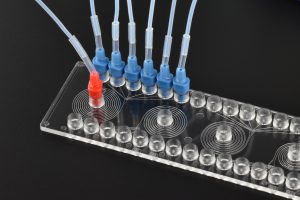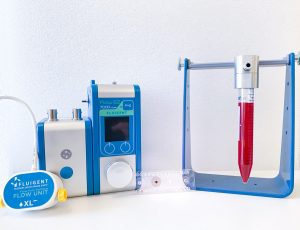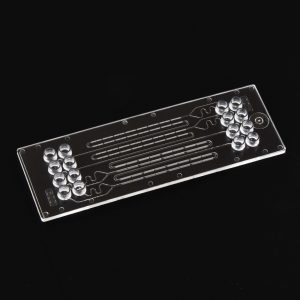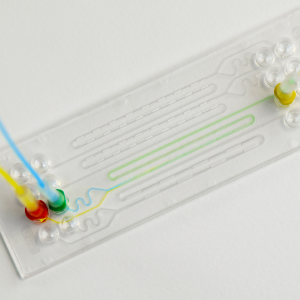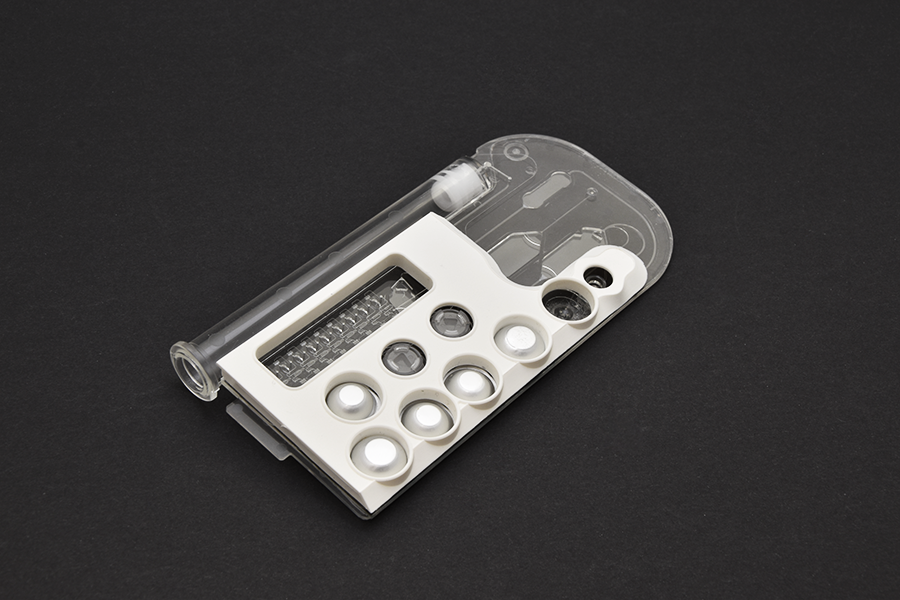Droplet generation using microfluidics has attracted a lot of interest due to the ability to produce highly monodispersed droplets with high frequency. The generation of droplets is based on the use of two immiscible phases: continuous phase (medium in which droplets flow) and dispersed phase (the droplet).
Handling Guides
Droplet generation
Overview on droplet generator chips, accessories, pump setups, kits and droplet oils
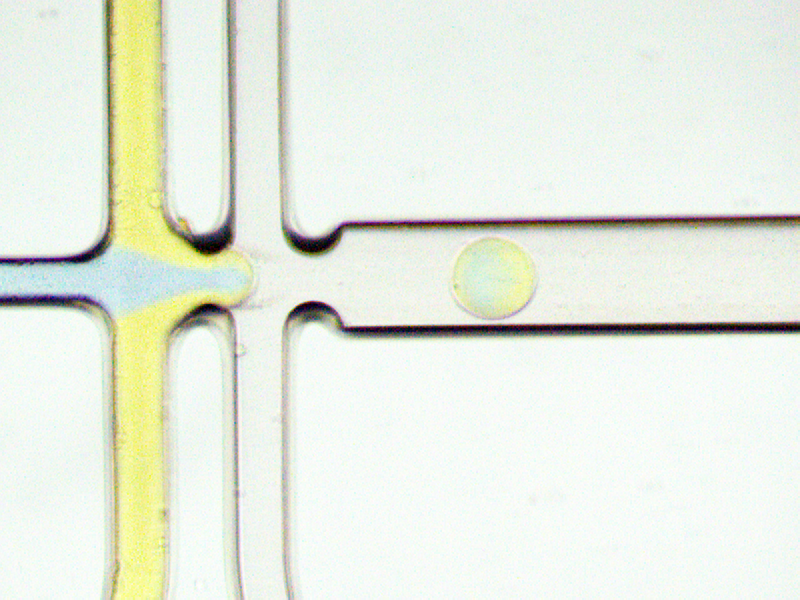
Droplet generator chip Fluidic 1032 – Multi channel design with double-cross geometry
Find out what microfluidic ChipShop has to offer to help you in successfully setting up your droplet generation experiment:
Overview on droplet generation
(PDF document, 10.763 KB)
Application Note for droplet generation (double emulsion) using Fluidic 1480
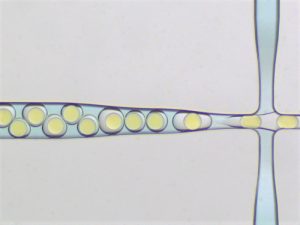
Droplet generation using chip Fluidic 1480
Fluidic 1480, a double emulsion droplet chip has two droplet generator units, each housing a double-cross geometry with variable channel and nozzle sizes at the second cross. Its specialized surface coating facilitates the generation of double emulsions, enabling the encapsulation of droplets, particles, or cells from the initial channel intersection within an additional droplet shell at the second channel cross.
Find the application note here:
(PDF document, 780 KB)
Application Note on real-time analysis of droplets

Droplet Generation Chip Fluidic 537 – Real-time analysis of generated droplets
Our collaboration with ZELLMECHANIK DRESDEN GmbH advances the analysis of microfluidic droplets. By combining our droplet generator chip Fluidic 537 (or any other droplet generator chips) with the DeCellerator device and RecoTeem software, we enable real-time monitoring of droplets.
Find the Application Note here:
Real-time analysis of droplets
(PDF document, 956 KB)
Membrane Chips
Membrane chips serve a variety of applications: from simple filtration tasks, plasma generation and dialysis to cell culture and Organ-on-chip applications. While the microfluidic chips themselves feature rather generic designs, the integration of our sophisticated membranes enables to achieve a wide range of different applications.
Overview on Filtration or Plasma Generation and Cross-Flow Membrane Chips
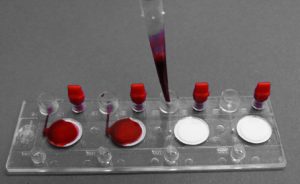 Plasma Generation Chips Fluidic 168 – Contains 4 membranes Plasma Generation
Plasma Generation Chips Fluidic 168 – Contains 4 membranes Plasma Generation
Two general design approaches from the microfluidic perspective are used to cope with the different applications, namely a membrane placed on a support structure for filtering or plasma generation tasks or cross-flow-membrane chips with a membrane as element that can be flooded with liquid from both sides.
Find the Flyer here:
(PDF document, 3.487 KB)
Cell-Culture and Organ-on-a-Chip
The introduction of microfluidic systems in cell culture,tissue culture and organ-on-a-chip experiments aims to Mimic Physiological Conditions in Vitro. For advanced cell culture requirements, our cross-flow membrane chips and interaction chips allow for the co-culture of various cell types.
Overview on Cell-Culture chips and kits
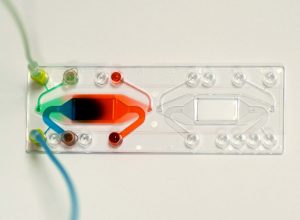
Cross-Flow membrane chip Fluidic 653 perfused with colored liquids
Find out what microfluidic ChipShops has to offer to help you in successfully setting up your Cell-Culture studies:
Product Flyer Cell-Culture and Organ-on-a-chip
(PDF document, 6.752 KB)
Application Note – Spiral Sorter Chip Fluidic 382
In this application note, we introduced a commercially-available microfluidic system to perform passive size separation of a microparticle mixture. The system includes a spiral-shaped microfluidic device from microfluidic ChipShop and pressure-based flow controllers from Fluigent. Tuning Dean and lift forces induced by spiral microchannels allow to obtain distinct particle streams and subsequently sort particles according to their sizes.
Application Note Fluidic 1147 – Loop-mediated isothermal amplification (LAMP)
microfluidic ChipShop offers different PCR-on-chip systems for the amplification and detection of bacterial nucleic acids, with relatively small reaction volumes ranging from 2.5 to 50 μL. Tremendously higher throughput can be achieved using droplet-based target gene amplification methods, with smaller reaction volumes. DNA samples are divided into thousands of small volume droplets in the range of approximately 0.2 – 2 nL. Amplification of target genes is performed in each droplet.
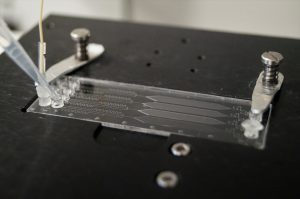
Fluidic 1147
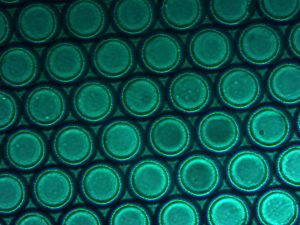
Bright field image showing LAMP of target genes within droplet reactors
Application Note – Herringbone Mixer Fluidic 1460
We have designed the Herringbone Mixer chip Fluidic 1460 with two different channel geometries. Due to the uniformly arranged mixing structures, the synthesis of lipid nanoparticles can be tailored to a defined size. In this application note, the synthesis of lipid nanoparticles is explained and described in a protocol.
Handling Instructions – 3D Serpentine Mixer Fluidic 1079
Many microfluidic systems require rapid mixing of different fluids within microchannels. While diffusion can be an effective mode of mixing in microchannels with predominantly laminar flows, it often requires prolonged mixing times and/or ideally increase of interfacial area.
Introducing chaotic (but still laminar) flow patterns can aid mixing efficiency in microchannels. This strategy becomes even more important when mixing solutions with particularly low diffusion coefficients. The 3D serpentine mixer has been developed especially to address this challenge in microfluidics. It is the perfect tool to investigate fast and efficient passive micromixing of up to three liquids.
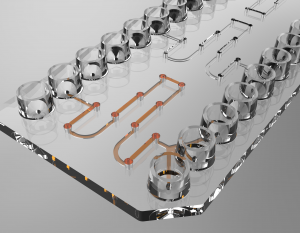
Fluidic 1079 – 3D Serpentine Mixer
Handling Instructions – Diffusion Mixer Fluidic 186
As flows in microchannels are usually laminar, mixing of liquids at microscale is a challenge but can be tackled using various approaches. One of the simplest methods for effective micromixing is to increase the interfacial areas between the fluids. Diffusion will cause the transfer of molecules through the interfacial area.
microfluidic ChipShop‘s diffusion mixer with its 217 mm long channel that enables a prolonged co-flow of fluids, makes use exactly of this principle.
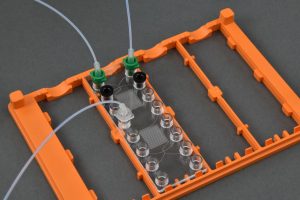
Fluidic 186 – Diffusion mixer
Handling Instructions – 2D Gradient Generator
In life science, tight control of the chemical environment is the basis for many experiments. A high spatial and timed resolution is key to successful experiments relying on gradients.
For this reason, we introduce the 2D Gradient Generator Fluidic 1166. It enables you to create gradients with up to six different fluids while at the same time allowing high control of flow and diffusion rates.
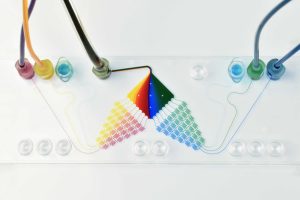
Fluidic 1166 – 2D Gradient Generator
Handling Instructions – Channel Interaction Chip 983
With the interaction chip family cell-cell interaction, of cells cultured in separate culture compartments, can be monitored. The channel interaction chip Fluidic 983, has been developed to study cells co-cultured in three adjacent channels, to each of which a microfluidic flow can be applied.
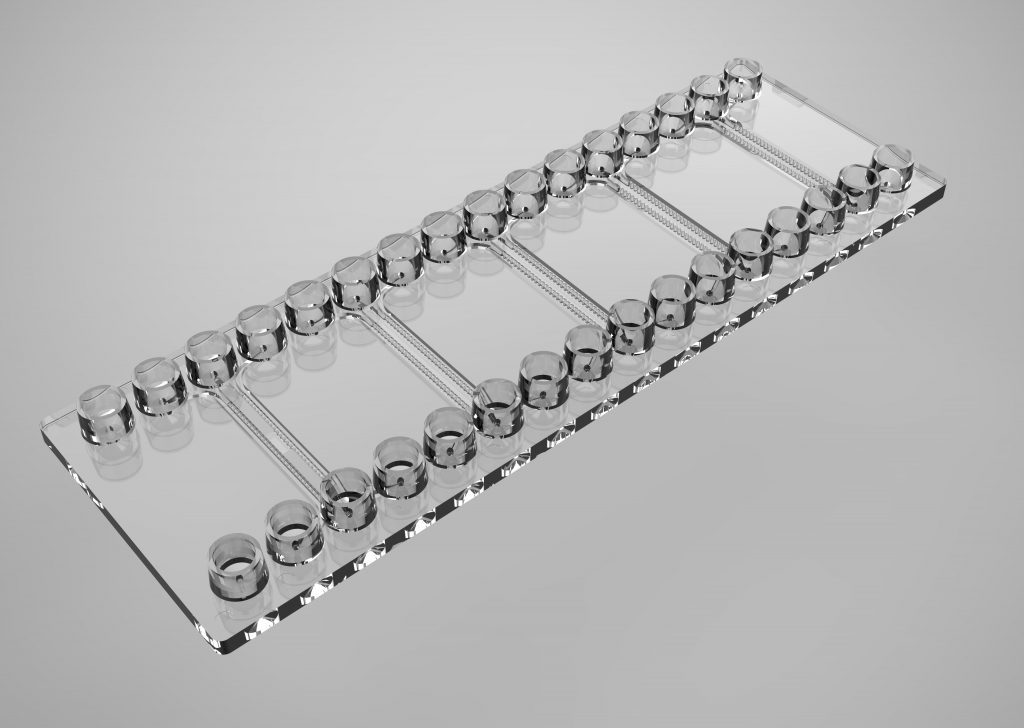
Fluidic 983 – Channel Interaction Chip
Handling Instructions – Cell Trap Chip 913
The isolation of individual cells can be particularly helpful in the analysis of cells and their communication with each other. For this reason, the cell trap chip Fl. 913 was developed. It enables you to collect individual cells and particles in wells where they can be monitored directly.
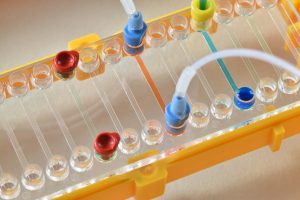
Fluidic 913 – Cell Trap Chip
General Handling Guide – Open Chip Platforms for Self-Assembly
The straight channel chip with double sided adhesive tape represents a microfluidic chip system for self-assembly that enables customized reagent and assay integration for various kinds of applications. For these purposes several chip types are at hand, having one or more integrated fluidic channels that remain open for manipulation at customer’s side.
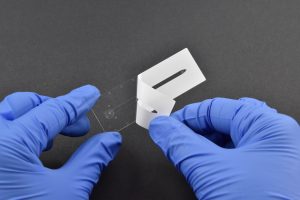
Straight channel chip Fluidic 268 – how to remove the protective film
Find the Handling Guide here:
General Handling Guide – Open Chip Platforms for Self-Assembly
(PDF document, 588 KB)
User Manual for ChipGenie® edition TSO
The ChipGenie® edition TSO allows for the temperature control of microfluidic chips in microscope slide format. A fixed temperature as well temperature cycling can be done to enable e.g. a fast PCR on chip. The ChipGenie® edition TSO is equipped with a fluorescence-based read-out unit to carry out the optical detection on microfluidic ChipShop’s chamber chips following the spacing of a 384 well plate of 4.5 mm with fixed read-out positions.
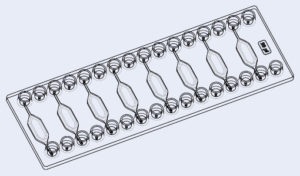
Reaction chamber chip Fluidic 584 – suited to be used for heatcycle applications, such as PCR experiments using the ChipGenie® edition T.
Flyer for ChipGenie® edition Dx
The ChipGenie® edition Dx is a customized diagnostic platform and its respective cartridge. The user chooses the sample and detection method. The ChipGenie® edition Dx is a fully automized point-of-care device working in a bleed-to-read fashion.

